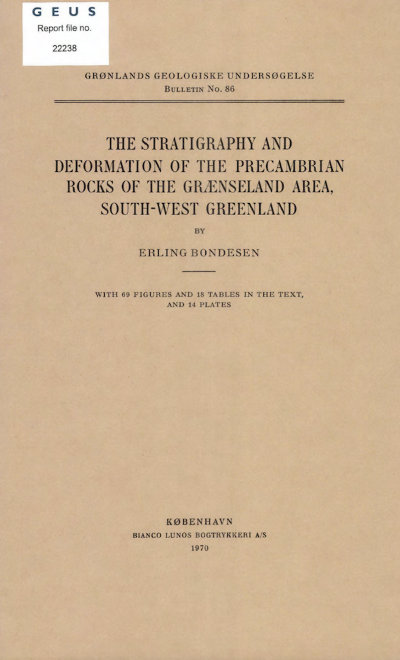The stratigraphy and deformation of the Precambrian rocks of the Grænseland area, South-West Greenland
DOI:
https://doi.org/10.34194/bullggu.v86.6626Abstract
The Grænseland area exhibits a middle Precambrian (Ketilidian) succession of unusually well preserved sediments, basic volcanics, and intrusives. A Ketilidian type lithostratigraphy is established and the evolution of the sedimentary basins is reconstructed. The sedimentation began on a weathered gneiss surface with residual gravel and arkoses. An early carbonate sedimentation led to a severe alteration of the gneiss substratum. Varved pelites and a magnetite-conglomerate with chert pebbles transgressed the earlier deposited sediments and the gneiss substratum; orthoquartzites were thereafter deposited in two basin structures. The deposition of dolomitic shales and pelites appears to indicate progressively increasing depth. Large amounts of graded greywackes, interpreted as turbitides, bear witness of unstable tectonic conditions and a subaqueous tallus indicates nearby fault activity. Filled with greywackes the basins appear to have stabilized, and a comparatively uniform euxenic facies of carbonaceous shales and dolomites with preserved organic remnants prevailed independent of the earlier basins in a period of tectonic quiescence. A considerable thickness of pillow lavas then appears to have been extruded under conditions of quiet subsidence during the euxenic conditions shown by the existence of an anthracite-carbonaceous shale layer and the local facies relations on top of the pillow lavas. A new phase of sedimentation appears to have taken place under conditions of tectonic activity and explosive volcanism. The total thickness of the Ketilidian strata in Grænseland is approximately 4400 m. This succession is compared with other areas of Ketilidian deposits in SouthWest Greenland. The Ketilidian deposits were deformed in two periods of folding, accompanied by thrusting and metamorphism under low greenshist facies conditions. The first deformation is a local drag in incompetent horizons and is possibly related to the tilting and twisting of the basement surface. The second deformation is of regional importance but of very different development depending on the material affected and its position in relation to the sedimentary basins and earlier formed structures. Some areas are virtually undeformed. The basement reacted to the deformations by brecciation and faulting. An analysis of lineations in a thrust zone indicates that the initially formed lineations were twisted and bent towards the direction of tectonic transport. A correlation, based on deformation of metadykes, is attempted with other areas of Ketilidian activity and it is suggested that the second deformation occurred close to 1635 m.y. and corresponds thus to the Sanerutian plutonic episode. The Ketilidian (1800 m.y.? -1500 m.y.) is envisaged as an orogenic cycle of deposition, folding and metamorphism beginning at and ending with major uncomformities. The basement gneisses are shown to contain evidence for two older (pre-Ketilidian) orogenic cycles.
Downloads
Published
Issue
Section
License
This article is distributed under a CC-BY 4.0 licence, permitting free redistribution and reproduction for any purpose, even commercial, provided proper citation of the original work. Author(s) retain copyright over the article contents.


